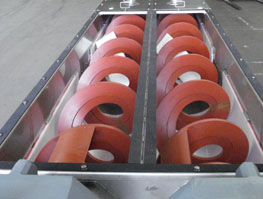Centreless screw conveyors, also known as shaftless screw conveyors, are designed to handle tough bulk materials. As a result, they’re one of the most versatile conveyors on the market, and they can be used in a wide range of industries.
With these conveyors, materials are transported using a shaftless screw or spiral that runs in a u-trough. These will have no end or intermediate bearings, making conveyance quick and obstacle-free.
Let’s look at how centreless screw conveyors work, what they are used for, and what industries can benefit from them.
What Materials Do Centreless Conveyors Transport?
Centreless screw conveyors can handle materials that may get stuck in standard conveyors. These materials are usually:
- Sticky or wet
- Highly abrasive (such as gravel or cinder)
- Materials like wood chips or paper that come with large or different sized particles
- Free-flowing materials (powder, chemicals, or ash)
This makes them an excellent solution for conveying waste materials, providing transport in the recycling process, transporting sewage sludge, and more. You’ll often find centreless conveyors in the food and transport industries and waste management services.
How Do Centreless Screw Conveyors Work?
Centreless Screw Conveyors have innovative design features. Their shaftless spirals allow them to provide higher throughput rates and low speeds. This is what makes them perfect for conveying tough materials.
With no end or intermediate bearings, they can maintain an efficient and direct material transfer. They’re typically made from steel and can be trough bolted or come with quick-release mechanisms.
They’re available in two designs: u-trough for horizontal inclines or octagonal (OK-trough) for steeper inclines and vertical transport.
Selecting The Right Centreless Screw Conveyor
To select and design the suitable centreless screw conveyor, you’ll need to consider several factors. These are:
- The trough size, length, and design
- The diameter of the spiral (plus pitch and model)
- The RPM of the gearbox and motor power
- The characteristics of the conveyed material
- The elevation angle of the conveyor
- The conveyor’s feed method
You should discuss your needs with a professional so you can select a suitable centreless screw conveyor for your processing needs.
The Right Spiral for Your Processes
The spiral is arguably an essential feature of your conveyor. Selecting the right one will determine how efficiently your conveyor can handle bulk materials. So what spiral do you need for your operation?
Single Section Spirals
You should consider a single section spiral if you need to transport materials horizontally or at an incline. These spirals are the lightest type you can choose from, and it’s commonly used for conveying at horizontal angles and for transporting at inclines of up to 45 degrees. This spiral is suitable for most applications, including sticky materials.
With the help of an experienced supplier, you can also explore a range of other spiral options for your screw conveyor. To match your required performance specifications, you can choose from a wide selection of cross-sections, spiral pitches and diameters.
If you’re conveying sludgey materials, you should talk to your supplier. They may recommend spirals with inserts and a scraping edge to prevent a build-up of material that can decrease the efficiency of your centreless screw conveyor.
U-Trough v OK Trough
Let’s take a look at the differences between U-troughs and ok-troughs.
U-Trough
The U-Trough design is simple and low-maintenance. They’re the most common types of troughs used in screw conveyors and screw feeders. They can be manufactured in small and large diameters, making them suitable for different purposes.
U-Trough systems can be custom-designed to cater to heavy-duty construction or to include special features like flights, bearings, covers, inlets, or mountings.
OK-Trough
The OK-Trough, or octagonal trough, is suitable for steeper inclines or verticle transport. They can significantly increase the efficiency of sludge transport and handling when paired with a centreless screw conveyor.
They’re most efficient when used at angles between 30 to 90 degrees. These troughs can also be enclosed to eliminate odours and reduce the risk of spillage. Suppose connections are required between multidirectional conveyors for horizontal, inclined, or vertical sludge transfers. In that case, the centreless spiral technology can provide a practical and efficient solution when paired with the octagonal trough.









